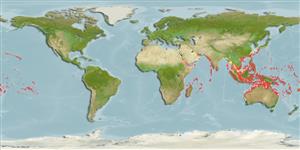Actinopterygii (ray-finned fishes) >
Perciformes (Perch-likes) >
Carangidae (Jacks and pompanos) > Caranginae
Etymology: Carangoides: French, carangue, the name of a Caribbean fish; 1836 (Ref. 45335).
Environment / Climate / Range
Ecology
Marine; brackish; reef-associated; depth range 1 - 60 m (Ref. 3197). Tropical, preferred ?; 37°N - 35°S, 25°E - 127°W
Indo-Pacific: Red Sea and East Africa (to Port Elizabeth, South Africa, Ref. 3197) to the Hawaiian Islands.
Size / Weight / Age
Maturity: Lm ? range ? - ? cm
Max length : 70.0 cm TL male/unsexed; (Ref. 3287); common length : 30.0 cm TL male/unsexed; (Ref. 9137); max. published weight: 8.0 kg (Ref. 3287)
Adults are found in coastal waters adjacent to sandy beaches; also found to depths of 60 m, often near reefs (Ref. 30573). Pelagic (Ref. 58302). Singly or in small groups (Ref. 48635). They feed mainly on mollusks, benthic crustaceans, and occasionally on small fish (Ref. 90102) that are abundant in the lagoons. Excellent food fish (Ref. 12484), the flesh is rarely poisonous.
Life cycle and mating behavior
Maturity | Reproduction | Spawning | Eggs | Fecundity | Larvae
Paxton, J.R., D.F. Hoese, G.R. Allen and J.E. Hanley, 1989. Pisces. Petromyzontidae to Carangidae. Zoological Catalogue of Australia, Vol. 7. Australian Government Publishing Service, Canberra, 665 p. (Ref. 7300)
IUCN Red List Status (Ref. 115185)
CITES (Ref. 94142)
Not Evaluated
Threat to humans
Reports of ciguatera poisoning (Ref. 31637)
Human uses
Fisheries: commercial; gamefish: yes
More information
Common namesSynonymsMetabolismPredatorsEcotoxicologyReproductionMaturitySpawningFecundityEggsEgg development
ReferencesAquacultureAquaculture profileStrainsGeneticsAllele frequenciesHeritabilityDiseasesProcessingMass conversion
Tools
Special reports
Download XML
Internet sources
